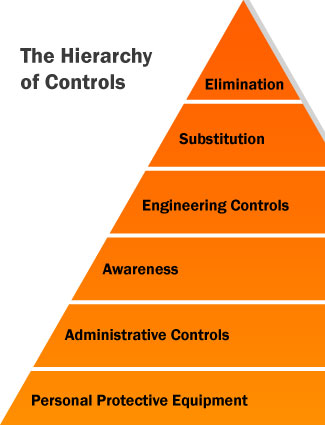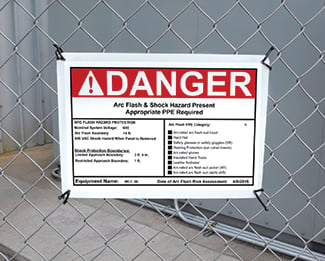Why Arc Flash Labels Matter for Electrical Safety

Why Are Arc Flash Labels Important?
When electrical equipment must be maintained or repaired while energized, an arc flash hazard may be present. Affected workers need to know what steps should be taken to stay safe. Arc flash warning labels can provide this information, right where and when it's needed. As a result, experts in electrical safety recommend using standardized and helpful arc flash labels and signs.
The most referenced standard for creating arc flash labels is NFPA 70E: Electrical Safety in the Workplace. While OSHA does not explicitly require employers to follow it, OSHA has used NFPA 70E as an example of recognized industry practices when evaluating a facility's electrical training, procedures, and signage, especially when it comes to arc flash.
New in 2018: The Hierarchy of Controls

In addition to arc flash labels, the NFPA 70E standard covers recommendations for electrical risk assessments, safe work practices, and protective equipment, making it a useful starting point for any facility's electrical safety program. The most significant change in the 2018 edition of the NFPA 70E was the inclusion of the Hierarchy of Controls. This is a clear and standardized way to think about protective measures, and is already in use as part of a Job Hazard Analysis in many workplaces.
The hierarchy gives more context to arc flash signs, showing where they fit into a facility's overall plan. Under this approach, protective measures are applied in order from most effective to least effective:
- Elimination - removing the hazard at its source
- Substitution - replacing a severe hazard with a less severe one
- Engineering Controls - blocking the hazard from affecting employees
- Awareness - providing information to allow employees to make safe decisions
- Administrative Controls - using safe work procedures to limit employee exposure to a hazard
- Personal Protective Equipment - using protective clothing and equipment to limit employee injuries from a harmful event
Under the current edition of NFPA 70E, arc flash warning labels are a critical part of step 4: Awareness. With that context, it's easy to see why arc flash warning labels are important for worker safety.
Arc Flash Label Details
Arc flash labels of some kind have been required by NFPA 70E for many years, and the essential information to be included on them has stayed the same since the 2015 edition. Each arc flash warning label needs to include:
- Nominal system voltage
- Arc flash boundary
- At least one of the following:
- Incident energy and working distance, or arc flash PPE category, but not both
- Minimum arc rating of clothing
- Site-specific description of PPE required
In the 2018 edition of NFPA 70E, these labeling requirements appear in Article 130.5(H).
First, the system voltage is a quick indicator of the equipment's power level. Then, the arc flash boundary provides a "stay-back" distance,
where a worker without protection would receive second-degree burns in the event of an arc flash; getting closer requires appropriate PPE. The third item is a way to indicate what PPE is required, with some options for how to present that information.
Note that a given piece of equipment should never be marked with both a calculated incident energy and an arc flash PPE category. This is because those two details reflect two different ways of assessing an arc flash hazard, and may give confusing or even conflicting recommendations:
- Incident energy must be calculated for the exact equipment and installation in question. This requires detailed knowledge of the system and some careful math, often performed with specialized analysis software. The IEEE 1584 standard provides a detailed approach for these calculations, and was updated in 2018.
- The arc flash PPE categories are generalized recommendations for some common circumstances. The appropriate category for a situation is found by reading tables in NFPA 70E. Where the PPE tables do not apply to a situation, the incident energy approach is needed.
Additional Label Content

Effective arc flash signs often include other elements, beyond that short list of required details. For example, labels may include shock protection information, such as the Limited and Restricted Approach Boundaries. It's also common practice to include the date of the last arc flash risk assessment, making it easy to check if a label is up-to-date; this is required by CSA Z462, the Canadian "sister standard" to NFPA 70E.
In addition to the information of the label, good arc flash labels often use a standardized format, described in the ANSI Z535 standard. This system uses a set of boldly colored headers and signal words to get attention and communicate quickly and clearly; the ANSI Z535 approach is often used to meet OSHA's requirements for accident prevention signs. Under this system, "Warning" signs (with an orange header and the word "Warning" at the top) indicate hazards that could cause serious injury or death, while "Danger" signs (with a red header and the word "Danger") mark the most extreme hazards.
Old Arc Flash Labels and the New Standard
Previous versions of NFPA 70E had different requirements for arc flash signs. For example, the 2009 edition only required either the incident energy or the required level of PPE. The 2004 edition didn't even go that far, only requiring a general warning that an arc flash hazard was present.
Under the 2018 edition of NFPA 70E, an older arc flash label may be kept in place as long as:
- the label complied with the requirements in effect at the time it was applied, and
- the label's information remains accurate
If your facility labeled its equipment under the 2015 edition of the standard, and the equipment and electrical distribution system have not been changed since then, your current labels may still be acceptable. However, your facility's arc flash risk assessments need to be reviewed each time the facility's electrical system is changed, and at least once every five years. Whenever a label is no longer accurate or legible, it should be replaced.
For customized warning labels or signs in your facility, consider a DuraLabel industrial label printer to let you create new labels when you need them, on-site and on demand. These printers include software for easy label design, and can even print labels directly from popular electrical analysis software.
Arc Flash labeling is complicated, so we've broken it down into a simple dos-and-don'ts format in our Arc Flash Labeling Do's and Don'ts PDF, which you can download for free below.
Related Resources

The Overlooked Fix That Improves Electrical Panel Safety
How Do Electrical Panel Labels Improve Safety and Compliance? Electrical panels are essential to every ...
Read
From Flash to Ash: Understanding Arc Flash Hazards and Prevention
What is Arc Flash? When it comes to electrical safety, arc flash is one of the most dangerous—and most ...
Read
NFPA 70E Arc Flash with OSHA Signs
What is NFPA 70E? NFPA 70E, or the NFPA’s Standard for Electrical Safety in the Workplace, outlines specific ...
Read.png)





